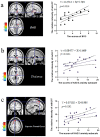The ALFF Alterations of Spontaneous Pelvic Pain in the Patients of Chronic Prostatitis/Chronic Pelvic Pain Syndrome Evaluated by fMRI
- PMID: 36291278
- PMCID: PMC9599805
- DOI: 10.3390/brainsci12101344
The ALFF Alterations of Spontaneous Pelvic Pain in the Patients of Chronic Prostatitis/Chronic Pelvic Pain Syndrome Evaluated by fMRI
Abstract
Chronic prostatitis/chronic pelvic pain syndrome (CP/CPPS) is a challenging entity with complicated symptoms for treatment in the male crowd. Accumulating evidence revealed the dysfunction in the central system should be a critical factor for the pathogenesis and development in the CP/CPPS. Therefore, we recruited 20 patients of CP/CPPS and 20 healthy male volunteers, aged 20 to 50 years. Through resting-state functional magnetic resonance imaging (fMRI), we analyzed the mean amplitude of low-frequency fluctuations (mALFF) and the mean fractional amplitude of low-frequency fluctuations (mfALFF) to reflect the spontaneous abnormal activated regions in the brains of CP/CPPS patients. Compared to the healthy controls, the group with CP/CPPS had significantly increased mALFF values in the thalamus and augmented fALFF values in the inferior parietal lobule and cingulate gyrus. Significant positive correlations were observed in the extracted mALFF values in the midbrain periaqueductal gray matter (PAG) and the pain intensity (r = 0.2712, p = 0.0019), mALFF values in the thalamus and the scores of Hospital Anxiety and Depression Scale (HADS) anxiety subscale (r = 0.08477, p = 0.0461), and mfALFF values in the superior frontal gyrus (SFG) and the scores of the HADS anxiety subscale (r = 0.07102, p = 0.0282). Therefore, we delineated the clinical alterations in patients of CP/CPPS that might be attributed to the functional abnormality of the thalamus, inferior parietal lobule, and cingulate gyrus. Among these regions, the PAG, thalamus, and SFG may further play an important role in the pathogenesis, with their regulating effect on pain or emotion.
Keywords: amplitude of low-frequency fluctuation; chronic prostatitis/chronic pelvic pain syndrome; fractional amplitude of low-frequency fluctuation; functional magnetic resonance imaging.
Conflict of interest statement
The authors declare no conflict of interest.
Figures



Similar articles
-
[Study on the changes of spontaneous brain activity in maintenance hemodialysis patients with end-stage renal disease based on three different resting state-functional magnetic resonance low-frequency amplitude algorithms].Zhonghua Yi Xue Za Zhi. 2021 Jan 26;101(4):265-270. doi: 10.3760/cma.j.cn112137-20200513-01524. Zhonghua Yi Xue Za Zhi. 2021. PMID: 33486935 Chinese.
-
Impaired frontal-parietal control network in chronic prostatitis/chronic pelvic pain syndrome revealed by graph theoretical analysis: A DTI study.Eur J Neurosci. 2021 Feb;53(4):1060-1071. doi: 10.1111/ejn.14962. Epub 2020 Dec 15. Eur J Neurosci. 2021. PMID: 32896914
-
Potential Alterations of Functional Connectivity Analysis in the Patients with Chronic Prostatitis/Chronic Pelvic Pain Syndrome.Neural Plast. 2021 May 7;2021:6690414. doi: 10.1155/2021/6690414. eCollection 2021. Neural Plast. 2021. PMID: 34035803 Free PMC article.
-
Contemporary Management of Chronic Prostatitis/Chronic Pelvic Pain Syndrome.Eur Urol. 2016 Feb;69(2):286-97. doi: 10.1016/j.eururo.2015.08.061. Epub 2015 Sep 26. Eur Urol. 2016. PMID: 26411805 Review.
-
Etiology of chronic prostatitis/chronic pelvic pain syndrome: psychoimmunoneurendocrine dysfunction (PINE syndrome) or just a really bad infection?World J Urol. 2013 Aug;31(4):725-32. doi: 10.1007/s00345-013-1061-z. Epub 2013 Apr 12. World J Urol. 2013. PMID: 23579440 Review.
Cited by
-
Urine Albumin-to-Creatinine Ratio as an Indicator of Brain Activity Changes in Chronic Kidney Disease: A Resting-State fMRI Study.Brain Behav. 2024 Oct;14(10):e70106. doi: 10.1002/brb3.70106. Brain Behav. 2024. PMID: 39417474 Free PMC article.
-
Deficits in the thalamocortical pathway associated with hypersensitivity to pain in patients with frozen shoulder.Front Neurol. 2023 May 17;14:1180873. doi: 10.3389/fneur.2023.1180873. eCollection 2023. Front Neurol. 2023. PMID: 37265462 Free PMC article.
-
Research progress of extracellular vesicles in the pathogenesis of type IIIA chronic prostatitis.Front Immunol. 2025 Feb 17;16:1496055. doi: 10.3389/fimmu.2025.1496055. eCollection 2025. Front Immunol. 2025. PMID: 40034709 Free PMC article. Review.
-
The characteristics of brain function alterations in patients with chronic prostatitis/chronic pelvic pain syndrome across varying symptom severities evaluated by NIH-CPSI.Front Neurosci. 2025 Feb 26;19:1511654. doi: 10.3389/fnins.2025.1511654. eCollection 2025. Front Neurosci. 2025. PMID: 40078709 Free PMC article.
-
Abnormal brain activity in lumbar disc herniation patients with chronic pain is associated with their clinical symptoms.Front Neurosci. 2023 Jul 28;17:1206604. doi: 10.3389/fnins.2023.1206604. eCollection 2023. Front Neurosci. 2023. PMID: 37575297 Free PMC article.
References
-
- Šutulović N., Grubač Ž., Šuvakov S., Jerotić D., Puškaš N., Macut D., Rašić-Marković A., Simić T., Stanojlović O., Hrnčić D. Experimental Chronic Prostatitis/Chronic Pelvic Pain Syndrome Increases Anxiety-Like Behavior: The Role of Brain Oxidative Stress, Serum Corticosterone, and Hippocampal Parvalbumin-Positive Interneurons. Oxid. Med. Cell Longev. 2021;2021:6687493. doi: 10.1155/2021/6687493. - DOI - PMC - PubMed
Grants and funding
LinkOut - more resources
Full Text Sources
Miscellaneous

